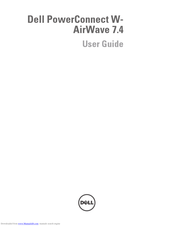Dell PowerConnect W-AirWave 7.4 Manuals
Manuals and User Guides for Dell PowerConnect W-AirWave 7.4. We have 5 Dell PowerConnect W-AirWave 7.4 manuals available for free PDF download: User Manual, Manual, Integration Manual, Quick Start Manual
Advertisement
Dell PowerConnect W-AirWave 7.4 Integration Manual (8 pages)
W-Airwave 7.4 AMP with Centralized NMS Event Correlation
Advertisement
Dell PowerConnect W-AirWave 7.4 Quick Start Manual (4 pages)
W-Airwave 7.4 Quick Start Guide
Dell PowerConnect W-AirWave 7.4 Manual (4 pages)
W-Airwave 7.4 Supported Infrastructure Devices
Advertisement
Related Products
- Dell OPENMANAGE 7.6
- Dell PowerConnect W-AirWave 7.3
- Dell PowerQuest DataKeeper PowerVault 701N/705N Edition
- Dell Server Administrator 7.2
- Dell PowerConnect W Airwave 7.1
- Dell PowerConnect W-Airwave Wireless Management Suite
- Dell PowerConnect W-AirWave 7.5
- Dell PowerConnect W AirWave 7.2
- Dell PowerConnect W-AirWave 7.2
- Dell OptiPlex 745c




